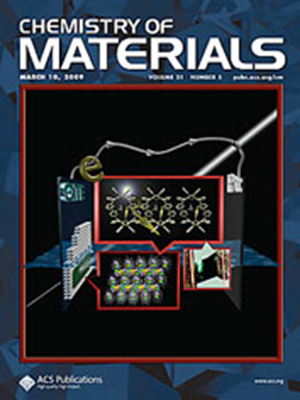高浓度条件下光致发光金属有机框架的受控生长和相互转换
IF 7.2
2区 材料科学
Q2 CHEMISTRY, PHYSICAL
引用次数: 0
摘要
大规模实现金属有机框架(MOF)的一个主要缺点是,在传统的稀释(~ 0.01 M)溶剂热条件下合成即使少量的MOF也需要大量的有机溶剂,通常是N,N-二甲基甲酰胺(DMF)。高浓度溶剂热方法提供了以最少的溶剂用量合成mof的机会,但目前由于缺乏对这些条件下动态自组装如何运作的理解而受到限制。本文以典型骨架Mg2(dobdc) (dobdc4 - = 2,5-二氧基-1,4-对苯二甲酸酯)的稀合成为基础,系统地研究了一系列mof在变浓度(0.01-0.2 M)和温度(80-160℃)条件下的结晶。通过这一分析,我们确定了导致高光致发光相Mg(DHT)(DMF)2 (DHT =二羟基对苯二甲酸酯)和玉米- mof -1 (Mg)(玉米=康奈尔大学)或Mg2(dobdc)分离的控制因素。最后,我们将特定MOF相的偏好与酸催化DMF水解的程度以及高浓度二甲胺(Me2NH)和甲酸(HCO2 -)的竞争影响联系起来,这同样受到温度、pH和溶剂组成的影响。我们利用这一发现首次合成了Fe、Co、Ni和Zn类似的玉米- mof -1,以及基于2-羟基对苯二甲酸(H3hbdc)的第二系列相关mof,玉米- mof -6 (M = Mg, Mn, Fe, Co, Ni)。这两个系列都表现出基于金属成分和晶体结构的可调谐发光特性,使它们成为光电应用的潜在有用材料。总的来说,这项工作有助于更清楚地了解高浓度条件下控制MOF形成的因素。本文章由计算机程序翻译,如有差异,请以英文原文为准。

Controlled Growth and Interconversion of Photoluminescent Metal–Organic Frameworks under High-Concentration Conditions
A major drawback to the implementation of metal–organic frameworks (MOFs) on scale is the vast quantity of organic solvents, typically N,N-dimethylformamide (DMF), required to synthesize even small quantities of MOF under traditional dilute (∼0.01 M) solvothermal conditions. High-concentration solvothermal methods offer the opportunity to synthesize MOFs with minimal solvent use but are currently limited by a lack of understanding of how dynamic self-assembly operates under these conditions. Herein, we systematically investigate the crystallization of a series of MOFs under variable concentration (0.01–0.2 M) and temperature (80–160 °C) conditions based on the dilute synthesis of the canonical framework Mg2(dobdc) (dobdc4– = 2,5-dioxido-1,4-terephthalate). Through this analysis, we identify controlling factors that lead to isolation of the highly photoluminescent phases Mg(DHT)(DMF)2 (DHT = dihydroxyterephthalate) and CORN-MOF-1 (Mg) (CORN = Cornell University) or Mg2(dobdc). Ultimately, we connect the preference for specific MOF phases to the extent of acid-catalyzed DMF hydrolysis and the competing influences of dimethylamine (Me2NH) and formate (HCO2–) at high concentrations, which is likewise affected by temperature, pH, and solvent composition. We use the insights gained to synthesize the Fe, Co, Ni, and Zn analogs of CORN-MOF-1 for the first time, as well as a second series of related MOFs, CORN-MOF-6 (M) (M = Mg, Mn, Fe, Co, Ni), based on the linker 2-hydroxyterephthalic acid (H3hbdc). Both series exhibit tunable luminescence properties based on the metal composition and crystal structure, making them potentially useful materials for optoelectronic applications. Overall, this work contributes to a clearer understanding of the factors that control MOF formation under high-concentration conditions.
求助全文
通过发布文献求助,成功后即可免费获取论文全文。
去求助
来源期刊

Chemistry of Materials
工程技术-材料科学:综合
CiteScore
14.10
自引率
5.80%
发文量
929
审稿时长
1.5 months
期刊介绍:
The journal Chemistry of Materials focuses on publishing original research at the intersection of materials science and chemistry. The studies published in the journal involve chemistry as a prominent component and explore topics such as the design, synthesis, characterization, processing, understanding, and application of functional or potentially functional materials. The journal covers various areas of interest, including inorganic and organic solid-state chemistry, nanomaterials, biomaterials, thin films and polymers, and composite/hybrid materials. The journal particularly seeks papers that highlight the creation or development of innovative materials with novel optical, electrical, magnetic, catalytic, or mechanical properties. It is essential that manuscripts on these topics have a primary focus on the chemistry of materials and represent a significant advancement compared to prior research. Before external reviews are sought, submitted manuscripts undergo a review process by a minimum of two editors to ensure their appropriateness for the journal and the presence of sufficient evidence of a significant advance that will be of broad interest to the materials chemistry community.
 求助内容:
求助内容: 应助结果提醒方式:
应助结果提醒方式:


